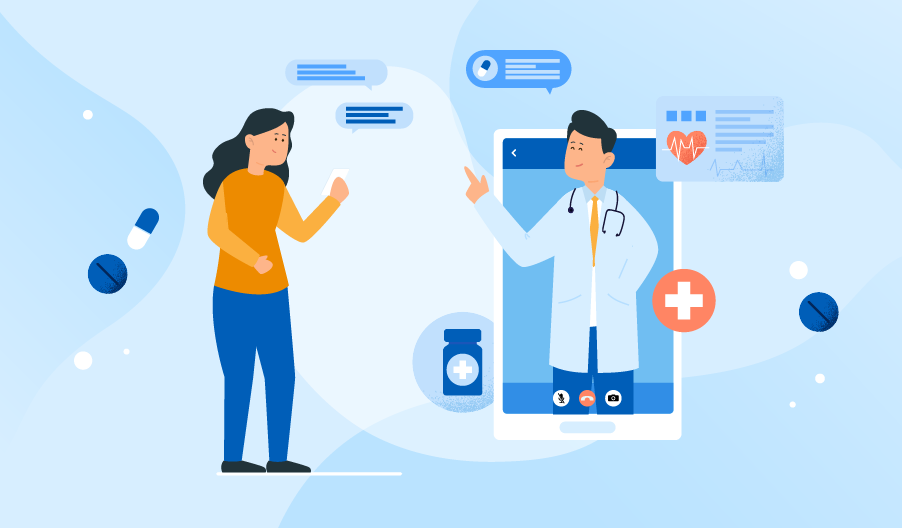
Remote Patient Monitoring Benefits
Last updated on June 23rd, 2022 at 04:23 am
Remote patient monitoring (RPM) is increasingly becoming the talk of the town and is becoming highly sought after by healthcare centers, especially in the wake of the Covid 19 pandemic.
Remote patient monitoring is a specialized digital technology that collects secure health information and data from a patient through the internet from any location and then transmits it to healthcare providers electronically. This invaluable practice portends a convenient and specialized healthcare solution that allows social distancing while simultaneously saving energy, time, money, and enhancing healthcare quality. It also allows medical professionals to monitor patients in their natural living environment even after their visit is over.
RPM holds innumerable benefits for both a medical care practitioner and a patient, and this article aims at highlighting three of them. Let’s get started!
1. RPM helps reduce hospital readmissions
Remote patient monitoring plays a consequential role in reducing readmissions and is thus being readily adopted by home health organizations, hospitals, and healthcare providers alike. Readmissions cost about $563 million to hospitals in the United States in 2020 alone, according to data from the Kaiser Family Foundation. In addition, hospitals stand to lose up to 3% of Medicare reimbursements because of readmission rates, according to the Affordable Care Act (ACA).
RPM played a vital role in reducing hospital readmission by almost 65% in several clinical trials of patients with congestive heart failure. Since remote patient monitoring collects biometric data, it helps medical health professionals evaluate and assess their patient’s vitals continuously from any possible location. Patients can themselves play an active part in their health management by using wearable mobile devices and related technology such as smartwatches and apps that use cloud-based device configuration tools. Such devices have specialized sensors that intimate health professionals regarding any emergencies, or possible emergencies.
2. RPM aids in reducing clinical burnout
The Association of American Medical Colleges (AAMC) predicts that the United States is bound to suffer from a shortage of primary healthcare providers (as many as 55,000 practitioners) in the coming twelve years. The U.S is expected to undergo population inflation of 10% at the same time, with the number of individuals over the age of 65 increasing by 45%. Remote patient monitoring can lend a helping hand in these circumstances, which have started showing signs in today’s post-Covid world.
It also contributes significantly to providing primary care doctors and specialists respite from work overload by uptaking the tasks that do not necessarily require a human touch. It is commonly physician assistants or nurses who are responsible for monitoring patient data and rooting out trends that can help in diagnosis, treatment, or treatment adjustments. By directly collaborating with medical health professionals, RPM allows doctors to become instantly invested in inpatient care. Remote patient monitoring can greatly relieve burnout from detached logistic tasks and enable professionals to devote their attention to tasks that matter more, like patient care.
In addition, a decrease in the number of doctor’s visits for patients with chronic diseases frees up a doctor’s capacity for other kinds of office visits or multitasking at a given time. They can conveniently keep tabs on their patients from afar while simultaneously continuing their other duties in a win-win scenario.
3. RPM enhances the quality of health care and its outcomes
Remote patient monitoring dramatically improves healthcare quality by eliminating the hassles of commuting to the medical professional’s clinic each time a patient senses fluctuations in their medical condition. It also eliminates the need to make appointments or visit diagnostic clinics to get basic tests done repeatedly. Similarly, both patients and doctors are least likely to miss their appointments or neglect significant test results and documents in remote patient monitoring, which directly elevates healthcare quality.
In addition, the data collected by RPM machines and devices plays a critical role in better patient management – by directly aiding in the assessment, diagnosis, and treatment of a patient. Evaluating patients’ physiological parameters and activities makes developing high-quality care plans easier and helps identify the causes or aggravating factors of certain conditions, such as hypertension or high blood glucose levels.
Patients are also more likely to comply with their treatment plans with a doctor virtually monitoring their situation and vitals, thereby improving healthcare outcomes. They also take a more active part in their treatment. HIMSS reports that about 60% of patients feel more empowered to manage their medical conditions when medical professionals view and discuss their self-generated health data.
You can now start your online care program with the top-notch remote patient monitoring platform offered by SmartClinix. May it be EMR, telehealth, or medical billing, experts at SmartClinix provide a one-stop portal for all your medical needs. Head over to SmartClinix right now to get started with your very own online hypertension, primary care, and cardiology program!
Read Dive is a leading technology blog focusing on different domains like Blockchain, AI, Chatbot, Fintech, Health Tech, Software Development and Testing. For guest blogging, please feel free to contact at readdive@gmail.com.
